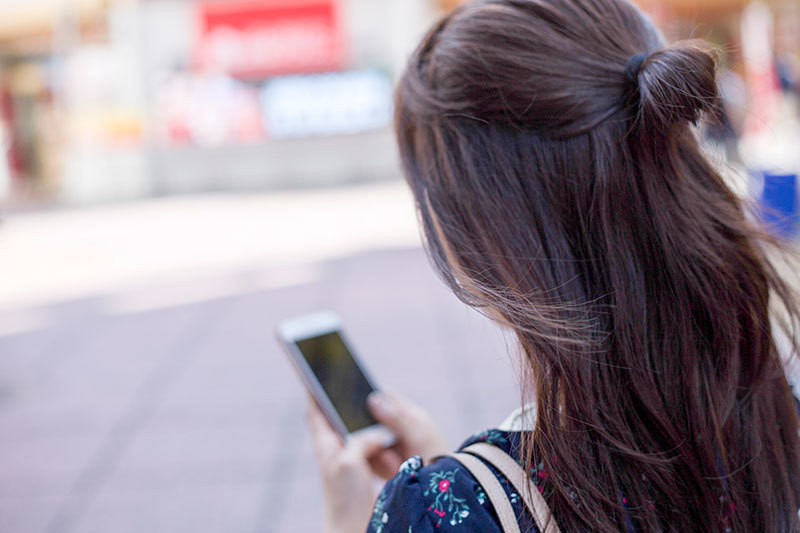Aさんはサッカーなどが好きなアクティブな面もありつつ、ファッションにも関心が高くて、クラスの人気者(=スクールカースト上位)なんだろうなと思わせる活発な方でした。
出品が少ないもの、あまり見かけないものを選んでいくそうです。つまり、「かぶり」を回避するためにメルカリが使われている―言い換えれば、そのバロメーターとしてメルカリの出品具合を確かめるとのことでした。これは目うろこの使い方でした。
最後に、仲の良さはタグ付けで決まるといった話も聞かせてくれました。どこかに遊びに行ったとき、その写真にタグ付けされるとうれしいし、自分も仲の良い友達はタグ付けするのだと。オンライン上の人間関係がオフライン上と途切れることなくつながっていることの証左だと感じさせるファインディングスです。
そして起業に関心が強いらしく、東洋経済や(イギリスの新聞である)The Economistを読んでいるというハイパー意識の高い高校生でした。難しい横文字もすらすら出てきてインタビュー中は本当に驚きました…!
そんな彼はSNSでのフォロワーも多いティーンフルエンサー度高めの男子高校生。
例えばTwitterは複数アカウントを運用して、情報収集用や友達・ファンとつながる用などなど、用途に分けて効率的に運用しているとのこと。
そこで特徴的だったのが推しマーク。「葉っぱのマーク(後で入れます)」をアカウント名に入れているのですが、それを彼のファンの子たちもマネしてアカウント名やプロフィールの中に入れていたりします。これが、SNSの中で、ユーザー同士がつながるための符丁(サイン)として機能していて、ファンたちとのコミュニティーを擬似的に生み出しているわけです。
このようにして、アプリそのものに実装されているわけではない機能を自分たちの工夫で実現してくという点に面白さを強く感じた次第です。
また、その他に注目しているアプリとして、Tik Tok、musical.lyなどショートリップシンクアプリを挙げていました。ショートリップシンクアプリとは15秒ほどの楽曲に合せて自分が口パクで歌うことのできるアプリ。それをMixChannelにも展開してシェアしたりするそうです。
私自身もこのショートシンクアプリに2018年も引き続き注目しており、「動画」というこれまでのコンテンツフォーマットに捉われない、気分をシェアするためのものとして捉える必要があると思っています。
テレビでもAbemaTVでも、欲しいのはリアリティー
Cさんはダンスが好きで、部活でも頑張ってるという一方、メークやコスメも好きで、確かな個性を感じられる今どきの女子でした。
インスタグラムはもちろん、Snapchatも活用しつつ、よくストーリーズでシェアしたり、友達の投稿を見るのがが好きなんだとか。Snapchatは加工機能が面白く今でも使われているようですね。
また、それらのアプリがうれしいのは、学校などメークできないときにこそ、盛るための加工アプリが活躍するということ。常に頼りっきりというわけではなく、メークができないシチュエーションにおいて思いっきり活用するということ。これは学校に通う高校生ならではのインサイトだなと思いました。
彼女はコスメを買ったり使ったりするとき、参考にするのはユーチューバーと述べていました。インスタグラマーもいいけど頼りにするのはユーチューバーのことが多いとか。詳細に説明できること、自分が知りたい商品などのネガティブな面も言ってくれることを評価しているようです。
動画世代との親和性の高さがここには関係しているでしょう。
そして、AbemaTVをよく見るという声も聞かれました。なぜか? あえて単純にまとめると、「そこにリアリティーがあるから」―だそうです。若者の恋愛をテーマにしたリアリティショーであったり、編集しない中継ものがあったりするのも。
逆にテレビはちょっとそれが足りないと言っていたのが印象的です。
ただその一方で、テレビにはオフィシャル感、お墨付き感があり、ニュースを通じて社会で起こっていることを知るために見るといった位置付けのようです。
3人のスマホライフから見えてくる三つのこと
(1)ティーンは、新しいつながり方を発明する
まず共通することとして、ティーンフルエンサーのスマホライフにおいてはSNSが欠かせないものでした。インスタグラムが大切な情報源で、そこから次の休みに遊びに行くスポットや友達と一緒に行くお店を決めたりするのだと。
また今回のヒアリングでは、「食べ物はFoodieで撮る」との声も目立ちました。このあたりはシェアを意識したインスタ映えの議論にもつながるでしょう。
そのようにインスタグラムやYouTubeのように人気アプリは固定化しつつ、一方で、Tik Tokやmusical.lyのようなショートリップシンクアプリといった新しいかたちのビジュアルコミュニケーションが広がりつつあることも確認できました。
さらには「推しマーク」でティーン独自のつながりを築くカルチャーが観察されました。
このあたりはまさにスマホカルチャーといい得るポイントでしょう。
(2)ショッピングはEC化からその一歩先のスマホ最適化へ
もう一つの気付きは、ショッピングの仕方がスマホを手にして劇的に変化しているということです。
インターネットで欲しいものが手軽に買えて便利…というEC化のフェーズを超えて、さらにその一歩先のスマホ最適化へ移行しているといえそうです。
メルカリに代表されるスマホコマースアプリが普及することで、モノを買うことがConsumer to Consumerで完結する面が強まりつつあります。そして、そのようにモノのやりとりのコストが低くなることで、それに関連するように買い替えのサイクルもどんどん短くなっているようです。
スマホがユーザーをよりショートアテンションにしたのと同様に、モノを持ち楽しむ期間自体もショートになりつつあるのではないか?という仮説を持ちました。
(3)Connect / Cut のバランス
最後に、その一方で、オフラインの時間を意識的につくるという声もあったことを紹介したいと思います。あえてスマホを切ってマンガを読みまくったり動画コンテンツを見まくったり…意外ですが、「スマホを使わない」時間も大切にされているようなのです。
ソーシャルから切断された上で、自分の世界観をつくるための時間を過ごすこと。そのConnect / Cut のバランスこそが、今のティーンフルエンサーのスマホカルチャーの必須要件なのだといえるでしょう。
全国で女子高生は約172万人。その中で37万件以上のエントリー(2016年度実績)を獲得しナンバーワンを決める、女子高生が選ぶ女子高生のためのミスコン。このミスコンの新しいところは、日本全国に設置されているプリクラ機でエントリー&投票可能なところ。選考過程では一般の方が主体となり、グランプリ決定までの過程を視聴者参加型で楽しめます。
【オフィシャル番組】
https://www.youtube.com/channel/UCEeyy_fypedVHh1Lscu16CQ
【Twitter】
http://j.mp/JKmisscon_Tw
【Instagram】
https://www.instagram.com/jkmisscon17/?hl=ja






